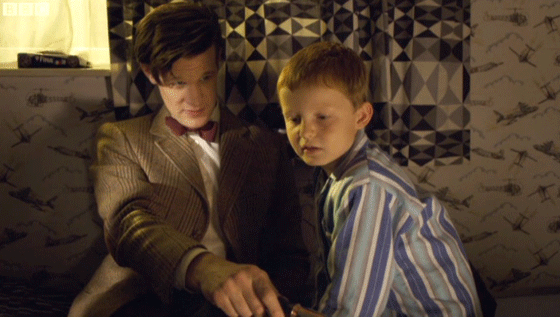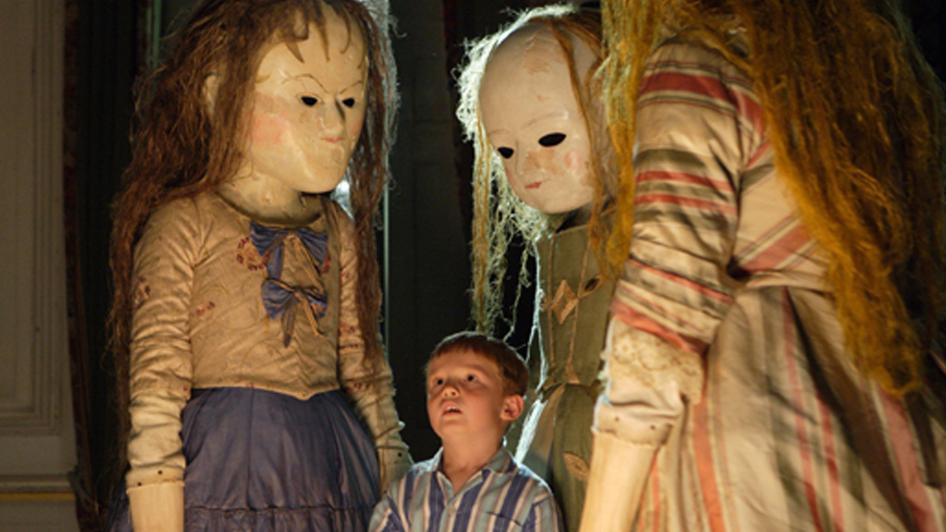REVIEW: Doctor Who - "Night Terrors"
I’m not surprised by the direction writer Mark Gatiss went with Saturday’s Doctor Who. The Doctor, Amy and Rory have come off a very hectic, but very fun, midseries premiere with “Let’s Kill Hitler”. Much in the way this series’ third episode “The Curse of the Black Spot” offered a brief break before the more ambitious fourth episode, “Night Terrors” feels like a similar effort to “cleanse the palate” before we move along to more epic fare.
“Night Terrors” turned out to be a solid episode more grounded in horror/fantasy than science fiction, though it still works well as a standalone component of Series Six. Read on for my full, spoiler-free review of “Night Terrors”, including my ranking out of four stars!
The Doctor takes Amy and Rory to a housing project in England to respond to the cries of help from a young boy. The boy, named George, is terrified of the monsters he believes live in his bedroom cupboard. George is so afraid of the contents of his cupboard that his pleas are picked up by the TARDIS is deep space. The Doctor soon discovers that George may be right about the monsters, and tries to help George and his father Alex conquer George’s fears, real or imagined.
This episode’s writer, Mark Gatiss, chose not to carry over much of the narrative from Episode 8. As a result, “Night Terrors” is a standalone Series Six entry, running on the strength of its competently conceived story and creepy atmosphere. There is no mention of the encounter with River Song or the continuing war with Madame Kovarian and her employers. “Night Terrors” is simply a straightforward Doctor Who episode, which admittedly is being used as “filler” until the series dives back into the River Song/Kovarian story arc.
One of the notable elements of this episode was the secondary casting. The young actor playing George was suitably wide-eyed and believably terrified – considering the amount of screen time he has, the performance didn’t feel wooden or inexperienced. Daniel Mays was also good as George’s father Alex – he effectively portrays a young father dealing with a recent layoff from work, who only wants the best for his young family. The landlord and old lady characters were stock characters, but still felt reasonably fleshed-out, even though they only appear in a few scenes.
The monsters in this episode have a much bigger role than the Teselecta did in “Let’s Kill Hitler”. There isn’t much question of whether the monsters – who happen to be human-sized Peg dolls – are real, because the Doctor wouldn’t be involved if there wasn’t a problem to fix. These Peg dolls are almost like zombies, constantly moving towards the heroes with the goal of turning their victims into dolls themselves. Unfortunately, the dolls are not explained beyond that, other than how they appear to be a physical manifestation of George’s fears.
It turns out that dolls have never been used as villains before in Doctor Who, according to Mark Gatiss. Personally, I found the Peg dolls fairly spooky, but the director didn’t quite use them in the right way. They were too much like the zombies of the current crop of monster movies, moving slowly forward with no other motivation than converting victims. The dolls could have been a bit more effective if they froze in place more often and pretended to be inanimate. This only happened once, leading to a missed opportunity to build tension.
Despite the few missteps with the villains, the creepy sound design for the episode was a significant element of the scenes inside the cupboard. The rumbling of the beat-up elevator (a vehicle used to take people away) in the block of flats is symbolically tied to George’s ultimate fear, that of his father rejecting him. Elsewhere, the eerie sing-song voices of the Peg dolls initially sound like a simple children’s song used for a frightening purpose, but there are actually some sinister lyrics if you listen closely, including the line, “…soon we all must die!”.
There is a definite symbolic connection in “Night Terrors” between the design of the apartment block and the doll house in the cupboard. The building is like a massive version of the doll house, equating the people inside the flats with the Peg dolls in the toy house. Just as George must conquer the evil forces in the doll house, the Doctor must face his enemies in the larger galactic arena. George is therefore like a younger version of the Doctor, learning how to take on the frightening things that threaten him. It’s this connection that makes the scene of the Doctor discussing his favourite bedtime stories all the more poignant.
I can see how some people might take issue with the sudden change in tone from last week – all that fluffy fan-service and rapid-fire plot development has lead to a detour into a status-quo Doctor Who episode. I, however, believe that it isn’t a major issue, because “Night Terrors” benefits from a solid story. Unlike the two-part story “The Rebel Flesh/The Almost People”, Episode 9 wraps this side-story up quickly. It’s an uncomplicated method of “sobering up” following “Let’s Kill Hitler”, before we dive back into all that timey-wimey goodness in the episodes to come.
Because of its solid story, believable secondary characters and the palate-cleansing content, “Night Terrors” gets three stars out of four.
What did you think of Episode 9 of Doctor Who? Did you find the Peg dolls creepy? Or did you feel that “Night Terrors” was a bit of a letdown after “Let’s Kill Hitler”? Let me know in the comments down below! If you’re enjoying my reviews of Doctor Who, consider adding me on Twitter to stay up to date on all my reviews, articles and random Tweets.
Check out all my reviews of Series Six of Doctor Who so far:
Episode 1: The Impossible Astronaut | Episode 2: Day of the Moon | Episode 3: The Curse of the Black Spot | Episode 4: The Doctor's Wife | Episode 5: The Rebel Flesh | Episode 6: The Almost People | Episode 7: A Good Man Goes to War | Episode 8: Let's Kill Hitler





